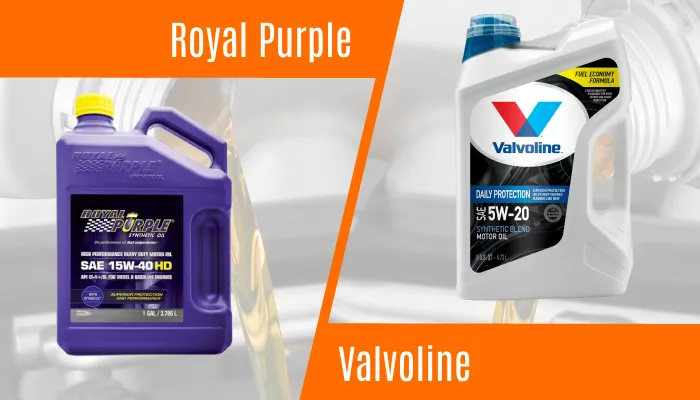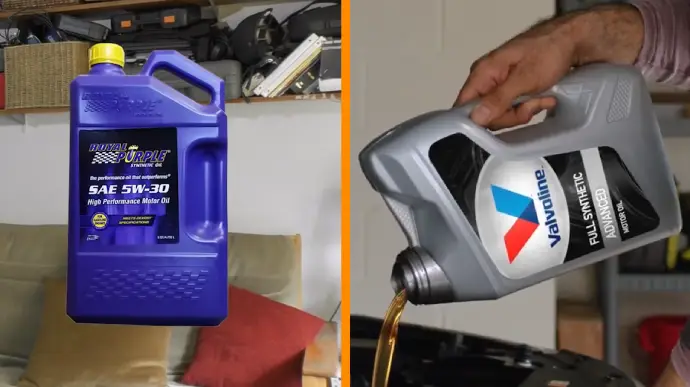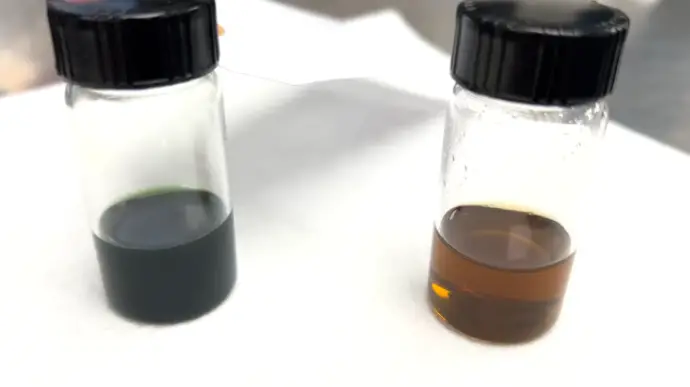Physical Address
304 North Cardinal St.
Dorchester Center, MA 02124
Physical Address
304 North Cardinal St.
Dorchester Center, MA 02124

When choosing a suitable engine oil for your vehicle, two popular brands often come into the spotlight: Royal Purple and Valvoline. Both offer a range of products, each with its characteristics and advantages. But there are several differences between them.
With a history dating back to 1866, Valvoline is an established brand trusted in over 100 countries. It has a wide range of engine oil products and is known for its reliability and affordability
However, founded in 1986, Royal Purple is a relatively new brand known for its premium synthetic lubricants. It has gained a strong following among car enthusiasts and racers for its focus on exceptional engine protection and performance.
Throughout this article, we’ll talk about the differences between Royal Purple and Valvoline oil. With its reputation in the automotive industry, you may wonder if Royal Purple truly outshines its competition.

Let’s examine the key differences between Royal Purple and Valvoline engine oil.
One key difference between Royal Purple and Valvoline engine oil is the extensive brand history of Valvoline, which spans over 150 years and has earned the trust of over 100 countries.
Valvoline, founded in 1866, has established itself as a reliable and affordable brand in the automotive industry. With its long history, Valvoline has built a strong reputation for producing quality lubricants that cater to the needs of a wide range of customers.
On the other hand, Royal Purple, founded in 1986, is a relatively new brand that has gained recognition among car enthusiasts and racers for its premium synthetic lubricants.
Royal Purple offers various viscosity options that cater to various engine types and climates. This flexibility makes it suitable for high-performance engines as well as everyday vehicles.
However, some users have noted that Valvoline may lack a 10W-xx version, which can be essential for certain climates and engine designs.
Choosing the right viscosity grade for your engine is important to ensure proper lubrication and protection. A higher viscosity grade, such as 10W-40, may be suitable for hotter climates or older engines, while a lower grade, like 5W-30, may be better for colder temperatures or newer engines.
The synthetic oil formulation of Royal Purple includes additives such as ethanol, zinc, and phosphorus to help prevent wear. These additives reduce wear and tear on engine parts, minimize friction, and enhance engine durability and performance.
Valvoline addresses common engine issues such as lower performance, rapid oil breakdown, and engine wear. Valvoline offers 40% better lubrication, reduced friction, and heat resistance.
Royal Purple’s synthetic oil is known for its ability to handle various temperatures, making it suitable for cold and hot environments. This means that Royal Purple will provide consistent performance and protection for your engine, whether you live in a freezing winter climate or a scorching summer area.
Conversely, Valvoline offers a balanced performance in various weather conditions. Its adaptability makes it a versatile choice for consumers who may experience fluctuating temperatures throughout the year.
Valvoline’s engine oil will ensure that your engine remains protected and performs optimally, regardless of the weather conditions you encounter.
There is no doubt that Royal Purple is compatible with modern engines and high-performance vehicles. It’s specifically formulated to meet the demands of newer cars with advanced engine designs.
In contrast, Valvoline is often recommended for older engines and is known for its reliability. It works well with various vehicle models and is particularly compatible with classic and vintage cars. Valvoline’s focus on versatility and adaptability makes it a popular choice for engines that may have different design specifications.
Royal Purple’s synthetic oil offers an interval of 25,000 to 75,000 miles between oil changes, making it suitable for occasional drivers.
Meanwhile, Valvoline provides better performance with an efficiency range of 75,000 to 150,000 miles, making it a great choice for those who drive long distances. Valvoline is particularly resistant to high temperatures, which benefits high-mileage vehicles that may experience increased heat.

The zinc levels (ZDDP) in Royal Purple and Valvoline engine oil differ significantly. Zinc is an essential additive that protects against wear and tear in engines.
Valvoline’s oil, specifically the 20W-50 version, contains high levels of ZDDP, making it suitable for classic cars with flat tappet cams. This high zinc concentration helps prevent camshaft and lifter damage caused by metal-to-metal contact.
In contrast, Royal Purple’s ZDDP levels may vary, as they aren’t explicitly mentioned. While Royal Purple is known for its advanced technology and high-performance capabilities, consider your engine’s specific needs before choosing an oil.
Royal Purple synthetic oil stands out with its vibrant purple hue, making it easily recognizable during oil changes. This unique color may be visually appealing to some users.
On the other hand, Valvoline oil typically has a clear and clean appearance when first used. This clarity allows users to easily monitor the condition of the oil, especially for those who frequently change their oil. The absence of any noticeable color in Valvoline oil may indicate it’s free from impurities or contaminants.
The Royal Purple oil, known for its premium engine protection and performance, tends to come with a higher price tag than other brands, making it a premium option.
Alternatively, Valvoline is recognized for its affordability, providing cost-effective options for consumers who prioritize good engine protection without breaking the bank.
While Royal Purple may offer top-notch performance, its higher cost mightn’t be justifiable for those on a tight budget. Valvoline, on the other hand, offers a more budget-friendly option without compromising on engine protection.
Here’s a comparison table summarizing the major differences between Royal Purple and Valvoline engine oils:
| Aspect | Royal Purple | Valvoline |
| Brand History | Founded in 1986, known for premium synthetic lubricants | Founded in 1866, trusted brand in over 100 countries |
| Synthetic vs. Conventional | Synthetic high-performance engine oil | Offers both conventional and synthetic options |
| Anti-Wear Additives | Contains ethanol, zinc, and phosphorus | Offers 40% better protection, reduced friction, and heat resistance |
| Weather Compatibility | Suitable for both cold and hot environments | Balanced performance in various weather conditions |
| Cost-Effectiveness | Relatively more expensive, premium option | Known for affordability and cost-effectiveness |
| High-Mileage Vehicles | 25,000 to 75,000 miles between oil changes | Efficiency range of 75,000 to 150,000 miles, high-temperature resistance |
| Zinc Levels (ZDDP) | ZDDP levels may vary, not explicitly disclosed | 20W-50 version contains high ZDDP levels |
| Viscosity Grades | Offers a wide range of viscosity options | Some versions may lack a 10W-xx option |
| Initial Appearance | Distinctive purple color | Clear and clean appearance |
| Engine Design Compatibility | Suitable for modern and high-performance vehicles | Compatible with a wide range of vehicle models |
| ZDDP Content Transparency | ZDDP levels not explicitly disclosed | Transparent about high ZDDP levels |

Regarding performance, Royal Purple synthetic oils are known for their exceptional quality. Including the Synerlec additive technology sets Royal Purple apart from other oils on the market.
This technology significantly increases the oil film strength, surpassing that of oils with similar viscosity by 3 to 4 times. The result is a lubricant that provides superior protection to your engine, reducing friction and wear.
While other oils may claim to be premium synthetic oils, Royal Purple’s Synerlec additive technology gives it a clear edge in terms of performance. However, note that each oil may have advantages, and choosing the oil that best suits your specific needs and preferences is recommended.
Both vehicle engine oils have their strengths and are popular choices among performance enthusiasts.
Royal Purple is known for its synthetic formulation, which provides superior engine protection, increased horsepower, and enhanced fuel efficiency. Conversely, Valvoline, particularly the 20W-50 version, is favored for its high zinc (ZDDP) levels, which can benefit engines with flat tappet cams.
Both oils have their advantages, and the choice ultimately depends on your engine’s specific needs. It’s recommended to consult with experts or do thorough research to determine which oil is the best fit for your high-performance engine.
Switching from Valvoline to Royal Purple can be done without significant issues if you follow the manufacturer’s recommendations for your vehicle and engine type. Ensure you choose the appropriate viscosity grade and oil type compatible with your engine. This will help maintain optimal performance and protection.
Both Valvoline and Royal Purple offer a range of high-quality motor oils that meet industry standards and specifications. However, it’s worth noting that Royal Purple is known for its advanced synthetic formulas and additives that provide enhanced lubrication and protection.
The choice between Royal Purple and Valvoline engine oils ultimately depends on your specific needs, budget, and vehicle requirements. Royal Purple and Valvoline battle rages on in the realm of engine oils.
Although both brands offer quality products, Royal Purple is a top contender for high-performance engines. Its innovative formula delivers exceptional lubrication and protection.
However, for those considering a switch from Valvoline to Royal Purple, rest assured that the transition can be made without encountering any issues. So, whether you choose the regal appeal of Royal Purple or the tried-and-true performance of Valvoline, both options will keep your engine running smoothly.
Last update on 2025-12-30 / Affiliate links / Images from Amazon Product Advertising API